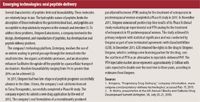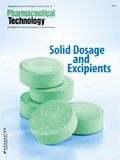Meeting Solubility Challenges
Pharmaceutical companies, equipment providers, contract-service providers, and excipient manufacturers apply various approaches for improving solubility. The article examines some recent developments.
The solubility of an API plays a crucial role in drug disposition because the main pathway for drug absorption is a function of permeability and solubility. Poor aqueous solubility is caused by two main factors: high hydrophobicity and highly crystalline structures. The aqueous solubility of a compound plays a role in its success or failure as a drug candidate. Better solubility results in better absorption in the gastrointestinal tract, reduced dosage-level requirements, and better bioavailability. In the development phase, poor solubility can lead to inadequate exposure in efficacy and toxicity studies. Higher dosages required to compensate for poor solubility can lead to side effects, food effects, and intersubject variability. It may drive up overall costs for drug development and production and lead to poor patient compliance because of the higher doses required to achieve a therapeutic effect (1). As pharmaceutical companies attempt to resolve these issues, contract-service providers and excipient suppliers are seeking to meet these challenges through targeted offerings.

MEDIOIMAGES/PHOTODISC/GETTY IMAGES
Strategies for improving solubility
Both physical and chemical methods can be used to improve drug solubility, Chemical methods to improve solubility include developing more soluble prodrugs or improving solubility through salt formation. Physical methods include micronization or nanosizing, producing a polymorph, changing the crystal habit, complexation, solubilization through self-microemulsifying drug-delivery systems, and solid dispersions (1).
The terms solid solution and solid dispersion define related compositions in which at least one active ingredient is dispersed in an inert matrix. In solid dispersions, separate regions of drug and polymer exist throughout the matrix, and the drug may be crystalline or be rendered in its amorphous state. A special subset of solid dispersions, solid solutions, refers to the case in which drug–polymer miscibility is attained at the molecular level, and the drug exists in its amorphous form. Pharmaceutical polymers are used to create this matrix. Polymer selection is based on many factors, including physicochemical (e.g., drug–polymer miscibility and stability) and pharmacokinetic (e.g., rate of absorption) constraints (1, 2).
Solid dispersions may be made through mechanical activation (i.e., cogrinding), coprecipitation, freeze drying, spray drying, melt extrusion, and KinetiSol technology (DisperSol Technologies), a fusion-processing technology. The solid-dispersion components consist of the API, the polymer, plasticizers, stabilizers, and other agents. Various polymers may be used in solid dispersions. These include methylacrylate polymers, polyvinyl acetate, polyvinylpyrrolidone, copovidone, poly-(ethylene-vinylacetate-vinylcaprolatam), and cellulose derivatives (e.g., hypromellose acetate succinate, hydroxypropyl methyl cellulose, hydroxypropyl cellulose, ethyl cellulose, and methyl cellulose) (1).
Hot-melt extrusion
Hot-melt extrusion is used to disperse APIs in a matrix at the molecular level to form solid solutions and is used as a method to improve solubility of poorly water-soluble drugs (3). Evonik has developed a system, Melt Extrusion Modeling and Formulation Information System (MEMFIS), as a predictive modeling tool in developing hot-melt extrusion formulations. MEMFIS helps in selecting initial formulations with no API consumption, using mathematical models and algorithms based on solubility parameter theories (i.e., hydrogen bonding and polar and dispersive forces). MEMFIS uses chemical structures, solubility parameters, physicochemical properties, and a myriad of processing conditions to suggest initial formulation components and process settings for a hot-melt extrusion formulation (1).
In terms of miscibility estimation, for example, MEMFIS evaluates which excipients have higher potential to form a solid solution by assessing the drug miscibility of a given excipient in comparison to other excipients. The qualitative method, (i.e., which excludes hydrogen-bonding capability in the evaluation) considers the drug miscibility with an excipient in comparison to other excipients to make the determination of whether one excipient is more or less miscible. Only dispersive interactions are considered. Qualitative-only methods may lead to the exclusion of valuable excipients from the screening studies that could potentially form strong hydrogen bonds with the APIs (1).
In the quantitative evaluation in the MEMFIS, which is a deeper analysis, in addition to polar and dispersive interactions, the specific possible hydrogen-bonding interactions are investigated at a molecular level to derive a quantitative expectation in terms of drug–excipient miscibility in a binary system. In this quantitative assessment, additional specific hydrogen-bonding capability is considered. This involves considering polymers from a monomer perspective (i.e., meaning the composition of the polymer) and specifying the type of hydrogen bonding that could be involved and its impact on the solubility parameters. Solubility-parameter estimation and molecular-interaction considerations are important tools in estimating first formulations in solid-dispersion product. High-throughput screening is accomplished based upon molecular structure, intra- and inter-molecular bonding, and their impact on solubility parameters (1). In addition to MEMFIS, Evonik is positioned in solid-dispersions through its methylacrylate polymers (Eudragit). Several late-stage products have been developed with these excipients in solid-solution formulations. Evonik has both hot-melt extrusion and spray-drying capabilities.
Other companies are advancing their hot-melt extrusion capabilities. In October 2011, Ashland Specialty Ingredients, which acquired International Specialty Products (ISP) in 2011, announced it was adding a GMP hot-melt extruder at its Columbia, Maryland, R&D center to better serve pharmaceutical companies working with poorly soluble drug compounds. The 180-mm Leistritz extruder allows companies that seek to commercialize drugs, which are made more soluble with dispersions from Ashland, to scale up to GMP clinical and commercial quantities produced by hot-melt extrusion. Ashland planned to finish installing and testing the equipment in the fourth quarter of 2011 and to begin a full-service offering early in 2012. The company has an existing extruder at its Wilmington, Delaware Research Center. With the addition of the extruder, Ashland is able to conduct kinetic-solubility and polymer-screening tests using both spray drying and hot-melt extrusion techniques to determine the best solubility solution in clinical trials. In October 2009, ISP launched a drug-solubility initiative that focused on solubilization technologies that involved excipients, formulation, and related processing services, which included solid-dispersion technology, both hot-melt extrusion and spray drying. In 2009, ISP partnered with the equipment manufacturer Coperion for advancing hot-melt extrusion technology.

Thin-film technology advances as a specialized oral dosage form
In February 2012, the CDMO Bend Research formed a licensing agreement with Eli Lilly under which Lilly gains access to Bend's proprietary spray-dried dispersion technology, which is designed to improve the bioavailability of compounds with low aqueous solubility. In addition, as part of an already existing agreement with Lilly, Bend Research will continue to provide formulation, development, analytical, engineering, and manufacturing services to Lilly to support its preclinical and clinical development programs. In August 2011. Bend Research also formed a collaboration with the CDMO Xcelience for oral solid-solubilization formulation solutions and clinical-supply manufacture.
In July 2011, the CDMO Pharmaceutics International (Pii) added hot-melt extrusion to its formulation and process-development solutions capabilites. The company purchased a 16-mm and an 18-mm Leistritz twin-screw extruders. This investment enables Pii to carry out feasibility studies to pilot-scale cGMP productionfor Phase I and II clinical-trial materials using hot-melt extrusion.

Emerging technologies: oral peptide delivery
In 2009, BASF launched its polymeric solubilizer, Soluplus, which is used in hot-melt extrusion applications. In 2010, the company partnered with GEA Niro to allow BASF to make cGMP spray-drying tests and pilot productions of APIs at GEA's test station in Copenhagen. Dow Wolf Cellulosics offers several expicients for hot-melt extrusion applications, including poly (ethylene) oxide resins (e.g., Polyox) and cellulosic derivatives [e.g., Ethocel (ethylcellulose ethers)] and Methocel (cellulose ethers).
In April 2011, the CDMO Pharmatek Laboratories added spray drying to its drug formulation and manufacturing capabilities. The company purchased a Buchi B-290 Mini Spray Dryer for formulation feasibility studies and small-scale clinical manufacture.
Academic research
Researchers at Purdue University recently reported on an extrusion-based approach where the dissolution rate of poorly soluble drugs (griseofulvin, phenytoin, and spironolactone) was improved through solid crystal suspensions. The drug and mannitol were coprocessed in a hot-melt extrusion operation. The resulting product was a mixture of the crystalline drug and crystalline excipient, with up to 50% (w/w) drug load. The in vitro drug release from the obtained solid crystalline suspensions was more than two orders of magnitude faster than that of the pure drug. The researchers reported that because the resulting product was crystalline, the accelerated dissolution rate did have the physical stability concerns as with amorphous formulations. The researchers reported this approach is useful in situations where the drug is not a good glass former or in cases where it is difficult to stabilize the amorphous drug (4).
References
1. P. Van Arnum, Pharm. Technol. 35 (10), 50–56 (2010).
2. J. Doney and J. Yang, Pharm. Technol. 32 (7), 96–98 (2008).
3. M. Karl, D. Djuric, and J. Kolter, Pharm. Technol. 35 (5), 74–82 (2011).
4. M. Thommers et al., Mol. Pharmaceutics 8 (3), 727–735 (2011).

Drug Solutions Podcast: A Closer Look at mRNA in Oncology and Vaccines
April 30th 2024In this episode fo the Drug Solutions Podcast, etherna’s vice-president of Technology and Innovation, Stefaan De Koker, discusses the merits and challenges of using mRNA as the foundation for therapeutics in oncology as well as for vaccines.
Drug Solutions Podcast: Applying Appropriate Analytics to Drug Development
March 26th 2024In this episode of the Drug Solutions Podcast, Jan Bekker, Vice President of Business Development, Commercial and Technical Operations at BioCina, discusses the latest analytical tools and their applications in the drug development market.
INTERPHEX 2025: Use of Walk-In Chambers for Bio/Pharma Development and Manufacturing
April 2nd 2025Sitting down with the PharmTech Group at INTERPHEX 2025, Christopher Murphy, director of Global Business Development and Service Customer Support at Environmental Specialties, discusses the design and critical role of walk-in chambers in the bio/pharmaceutical industry.